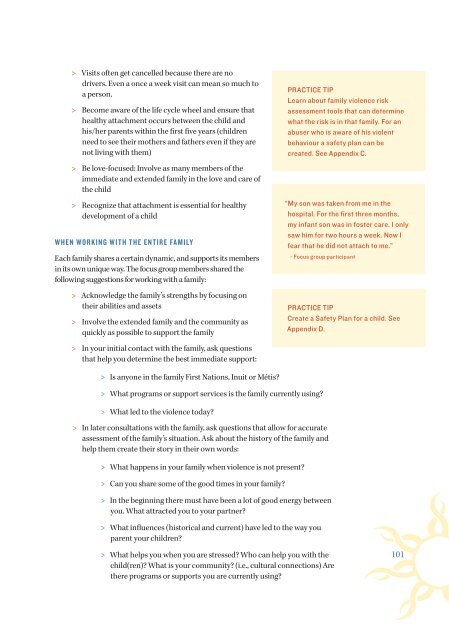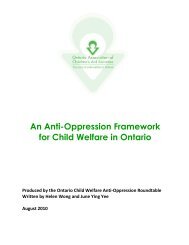English - Ontario Association of Children's Aid Societies
English - Ontario Association of Children's Aid Societies
English - Ontario Association of Children's Aid Societies
You also want an ePaper? Increase the reach of your titles
YUMPU automatically turns print PDFs into web optimized ePapers that Google loves.
Visits <strong>of</strong>ten get cancelled because there are no<br />
drivers. Even a once a week visit can mean so much to<br />
a person.<br />
> > Become aware <strong>of</strong> the life cycle wheel and ensure that<br />
healthy attachment occurs between the child and<br />
his/her parents within the first five years (children<br />
need to see their mothers and fathers even if they are<br />
not living with them)<br />
> > Be love-focused: Involve as many members <strong>of</strong> the<br />
immediate and extended family in the love and care <strong>of</strong><br />
the child<br />
> > Recognize that attachment is essential for healthy<br />
development <strong>of</strong> a child<br />
WHEN WORKING WITH THE ENTIRE FAMILY<br />
Each family shares a certain dynamic, and supports its members<br />
in its own unique way. The focus group members shared the<br />
following suggestions for working with a family:<br />
> > Acknowledge the family’s strengths by focusing on<br />
their abilities and assets<br />
> > Involve the extended family and the community as<br />
quickly as possible to support the family<br />
> > In your initial contact with the family, ask questions<br />
that help you determine the best immediate support:<br />
PRACTICE TIP<br />
Learn about family violence risk<br />
assessment tools that can determine<br />
what the risk is in that family. For an<br />
abuser who is aware <strong>of</strong> his violent<br />
behaviour a safety plan can be<br />
created. See Appendix C.<br />
“My son was taken from me in the<br />
hospital. For the first three months,<br />
my infant son was in foster care. I only<br />
saw him for two hours a week. Now I<br />
fear that he did not attach to me.”<br />
- Focus group participant<br />
PRACTICE TIP<br />
Create a Safety Plan for a child. See<br />
Appendix D.<br />
> Is anyone in the family First Nations, Inuit or Métis<br />
> What programs or support services is the family currently using<br />
> What led to the violence today<br />
> > In later consultations with the family, ask questions that allow for accurate<br />
assessment <strong>of</strong> the family’s situation. Ask about the history <strong>of</strong> the family and<br />
help them create their story in their own words:<br />
> What happens in your family when violence is not present<br />
> Can you share some <strong>of</strong> the good times in your family<br />
> In the beginning there must have been a lot <strong>of</strong> good energy between<br />
you. What attracted you to your partner<br />
> What influences (historical and current) have led to the way you<br />
parent your children<br />
> What helps you when you are stressed Who can help you with the<br />
child(ren) What is your community (i.e., cultural connections) Are<br />
there programs or supports you are currently using<br />
101

















